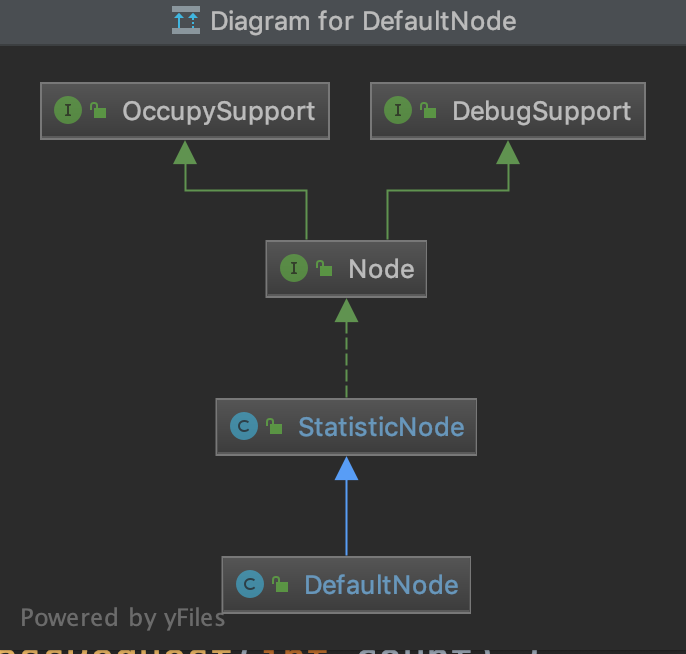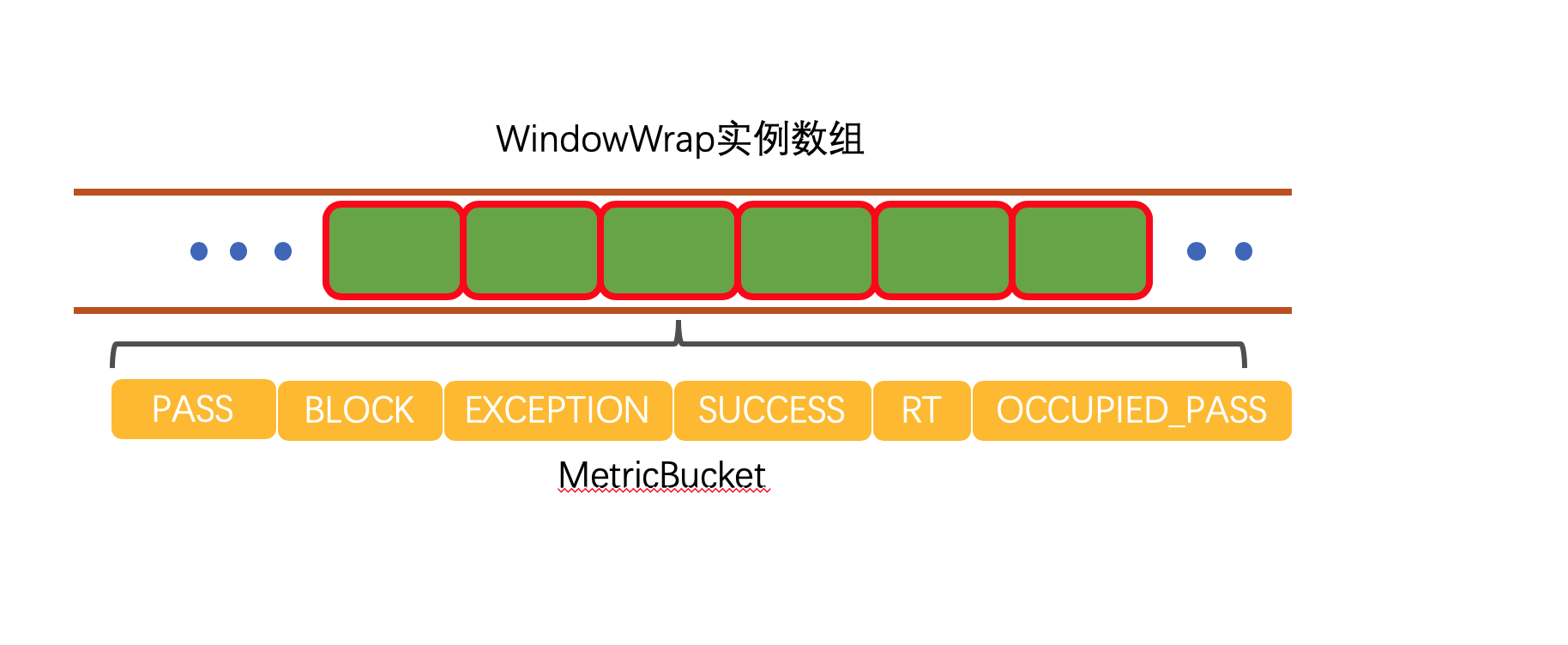2. Sentinel原始碼分析—Sentinel是如何進行流量統計的?
這一篇我還是繼續上一篇沒有講完的內容,先上一個例子:
private static final int threadCount = 100; public static void main(String[] args) { initFlowRule(); for (int i = 0; i < threadCount; i++) { Thread entryThread = new Thread(new Runnable() { @Override public void run() { while (true) { Entry methodA = null; try { TimeUnit.MILLISECONDS.sleep(5); methodA = SphU.entry("methodA"); } catch (BlockException e1) { // Block exception } catch (Exception e2) { // biz exception } finally { if (methodA != null) { methodA.exit(); } } } } }); entryThread.setName("working thread"); entryThread.start(); } } private static void initFlowRule() { List<FlowRule> rules = new ArrayList<FlowRule>(); FlowRule rule1 = new FlowRule(); rule1.setResource("methodA"); // set limit concurrent thread for 'methodA' to 20 rule1.setCount(20); rule1.setGrade(RuleConstant.FLOW_GRADE_THREAD); rule1.setLimitApp("default"); rules.add(rule1); FlowRuleManager.loadRules(rules); }
SphU#entry
我先把例子放上來
Entry methodA = null; try { methodA = SphU.entry("methodA"); // dosomething } catch (BlockException e1) { block.incrementAndGet(); } catch (Exception e2) { // biz exception } finally { total.incrementAndGet(); if (methodA != null) { methodA.exit(); } }
我們先進入到entry方法裡面:
SphU#entry
public static Entry entry(String name) throws BlockException {
return Env.sph.entry(name, EntryType.OUT, 1, OBJECTS0);
}這個方法裡面會呼叫Env的sph靜態方法,我們進入到Env裡面看看
public class Env { public static final Sph sph = new CtSph(); static { // If init fails, the process will exit. InitExecutor.doInit(); } }
這個方法初始化的時候會呼叫InitExecutor.doInit()
InitExecutor#doInit
public static void doInit() {
//InitExecutor只會初始化一次,並且初始化失敗會退出
if (!initialized.compareAndSet(false, true)) {
return;
}
try {
//通過spi載入InitFunc子類,預設是MetricCallbackInit
ServiceLoader<InitFunc> loader = ServiceLoader.load(InitFunc.class);
List<OrderWrapper> initList = new ArrayList<OrderWrapper>();
for (InitFunc initFunc : loader) {
RecordLog.info("[InitExecutor] Found init func: " + initFunc.getClass().getCanonicalName());
//由於這裡只有一個loader裡面只有一個子類,那麼直接就返回initList裡面包含一個元素的集合
insertSorted(initList, initFunc);
}
for (OrderWrapper w : initList) {
//這裡呼叫MetricCallbackInit的init方法
w.func.init();
RecordLog.info(String.format("[InitExecutor] Executing %s with order %d",
w.func.getClass().getCanonicalName(), w.order));
}
} catch (Exception ex) {
RecordLog.warn("[InitExecutor] WARN: Initialization failed", ex);
ex.printStackTrace();
} catch (Error error) {
RecordLog.warn("[InitExecutor] ERROR: Initialization failed with fatal error", error);
error.printStackTrace();
}
}這個方法主要是通過spi載入InitFunc 的子類,預設是MetricCallbackInit。
然後會將MetricCallbackInit封裝成OrderWrapper例項,然後遍歷,呼叫
MetricCallbackInit的init方法:
MetricCallbackInit#init
public void init() throws Exception {
//添加回調函式
//key是com.alibaba.csp.sentinel.metric.extension.callback.MetricEntryCallback
StatisticSlotCallbackRegistry.addEntryCallback(MetricEntryCallback.class.getCanonicalName(),
new MetricEntryCallback());
//key是com.alibaba.csp.sentinel.metric.extension.callback.MetricExitCallback
StatisticSlotCallbackRegistry.addExitCallback(MetricExitCallback.class.getCanonicalName(),
new MetricExitCallback());
} 這個init方法就是註冊了兩個回撥例項MetricEntryCallback和MetricExitCallback。
然後會通過呼叫Env.sph.entry會最後呼叫到CtSph的entry方法:
public Entry entry(String name, EntryType type, int count, Object... args) throws BlockException {
//這裡name是Resource,type是out
StringResourceWrapper resource = new StringResourceWrapper(name, type);
//count是1 ,args是一個空陣列
return entry(resource, count, args);
}這個方法會將resource和type封裝成StringResourceWrapper例項,然後呼叫entry過載方法追蹤到CtSph的entryWithPriority方法。
//這裡傳入得引數count是1,prioritized=false,args是容量為1的空陣列
private Entry entryWithPriority(ResourceWrapper resourceWrapper, int count, boolean prioritized, Object... args)
throws BlockException {
//獲取當前執行緒的上下文
Context context = ContextUtil.getContext();
if (context instanceof NullContext) {
// The {@link NullContext} indicates that the amount of context has exceeded the threshold,
// so here init the entry only. No rule checking will be done.
return new CtEntry(resourceWrapper, null, context);
}
//為空的話,建立一個預設的context
if (context == null) { //1
// Using default context.
context = MyContextUtil.myEnter(Constants.CONTEXT_DEFAULT_NAME, "", resourceWrapper.getType());
}
// Global switch is close, no rule checking will do.
if (!Constants.ON) {//這裡會返回false
return new CtEntry(resourceWrapper, null, context);
}
//2
//建立一系列功能插槽
ProcessorSlot<Object> chain = lookProcessChain(resourceWrapper);
/*
* Means amount of resources (slot chain) exceeds {@link Constants.MAX_SLOT_CHAIN_SIZE},
* so no rule checking will be done.
*/
//如果超過了插槽的最大數量,那麼會返回null
if (chain == null) {
return new CtEntry(resourceWrapper, null, context);
}
Entry e = new CtEntry(resourceWrapper, chain, context);
try {
//3
//呼叫責任鏈
chain.entry(context, resourceWrapper, null, count, prioritized, args);
} catch (BlockException e1) {
e.exit(count, args);
throw e1;
} catch (Throwable e1) {
// This should not happen, unless there are errors existing in Sentinel internal.
RecordLog.info("Sentinel unexpected exception", e1);
}
return e;
}這個方法是最核心的方法,主要做了三件事:
- 如果context為null則建立一個新的
- 通過責任鏈方式建立功能插槽
- 呼叫責任鏈插槽
在講建立context之前我們先看一下ContextUtil這個類初始化的時候會做什麼
ContextUtil
/**
* Holds all {@link EntranceNode}. Each {@link EntranceNode} is associated with a distinct context name.
*/
private static volatile Map<String, DefaultNode> contextNameNodeMap = new HashMap<>();
static {
// Cache the entrance node for default context.
initDefaultContext();
}
private static void initDefaultContext() {
String defaultContextName = Constants.CONTEXT_DEFAULT_NAME;
//初始化一個sentinel_default_context,type為in的隊形
EntranceNode node = new EntranceNode(new StringResourceWrapper(defaultContextName, EntryType.IN), null);
//Constants.ROOT會初始化一個name是machine-root,type=IN的物件
Constants.ROOT.addChild(node);
//所以現在map裡面有一個key=CONTEXT_DEFAULT_NAME的物件
contextNameNodeMap.put(defaultContextName, node);
} ContextUtil在初始化的時候會先呼叫initDefaultContext方法。通過Constants.ROOT建立一個root節點,然後將建立的node作為root的子節點入隊,然後將node節點put到contextNameNodeMap中
結構如下:
Constants.ROOT:
machine-root(EntryType#IN)
/
/
sentinel_default_context(EntryType#IN)現在我們再回到entryWithPriority方法中:
if (context == null) {//1
// Using default context.
context = MyContextUtil.myEnter(Constants.CONTEXT_DEFAULT_NAME, "", resourceWrapper.getType());
}如果context為空,那麼會呼叫MyContextUtil.myEnter建立一個新的context,這個方法最後會呼叫到ContextUtil.trueEnter方法中進行建立。
protected static Context trueEnter(String name, String origin) {
Context context = contextHolder.get();
if (context == null) {
Map<String, DefaultNode> localCacheNameMap = contextNameNodeMap;
DefaultNode node = localCacheNameMap.get(name);
if (node == null) {
//如果為null的話,檢查contextNameNodeMap的size是不是超過2000
if (localCacheNameMap.size() > Constants.MAX_CONTEXT_NAME_SIZE) {
setNullContext();
return NULL_CONTEXT;
} else {
// 重複initDefaultContext方法的內容
try {
LOCK.lock();
node = contextNameNodeMap.get(name);
if (node == null) {
if (contextNameNodeMap.size() > Constants.MAX_CONTEXT_NAME_SIZE) {
setNullContext();
return NULL_CONTEXT;
} else {
node = new EntranceNode(new StringResourceWrapper(name, EntryType.IN), null);
// Add entrance node.
Constants.ROOT.addChild(node);
Map<String, DefaultNode> newMap = new HashMap<>(contextNameNodeMap.size() + 1);
newMap.putAll(contextNameNodeMap);
newMap.put(name, node);
contextNameNodeMap = newMap;
}
}
} finally {
LOCK.unlock();
}
}
}
context = new Context(node, name);
context.setOrigin(origin);
contextHolder.set(context);
}
return context;
}在trueEnter方法中會做一個校驗,如果contextNameNodeMap中的數量已經超過了2000,那麼會返回一個NULL_CONTEXT。由於我們在initDefaultContext中已經初始化過了node節點,所以這個時候直接根據name獲取node節點放入到contextHolder中。
建立完了context之後我們再回到entryWithPriority方法中繼續往下走:
//建立一系列功能插槽
ProcessorSlot<Object> chain = lookProcessChain(resourceWrapper);通過呼叫lookProcessChain方法會建立功能插槽
CtSph#lookProcessChain
ProcessorSlot<Object> lookProcessChain(ResourceWrapper resourceWrapper) {
//根據resourceWrapper初始化插槽
ProcessorSlotChain chain = chainMap.get(resourceWrapper);
if (chain == null) {
synchronized (LOCK) {
chain = chainMap.get(resourceWrapper);
if (chain == null) {
// Entry size limit.最大插槽數量為6000
if (chainMap.size() >= Constants.MAX_SLOT_CHAIN_SIZE) {
return null;
}
//初始化新的插槽
chain = SlotChainProvider.newSlotChain();
Map<ResourceWrapper, ProcessorSlotChain> newMap = new HashMap<ResourceWrapper, ProcessorSlotChain>(
chainMap.size() + 1);
newMap.putAll(chainMap);
newMap.put(resourceWrapper, chain);
chainMap = newMap;
}
}
}
return chain;
}這裡會呼叫SlotChainProvider.newSlotChain進行插槽的初始化。
SlotChainProvider#newSlotChain
public static ProcessorSlotChain newSlotChain() {
if (slotChainBuilder != null) {
return slotChainBuilder.build();
}
//根據spi初始化slotChainBuilder,預設是DefaultSlotChainBuilder
resolveSlotChainBuilder();
if (slotChainBuilder == null) {
RecordLog.warn("[SlotChainProvider] Wrong state when resolving slot chain builder, using default");
slotChainBuilder = new DefaultSlotChainBuilder();
}
return slotChainBuilder.build();
}預設呼叫DefaultSlotChainBuilder的build方法進行初始化
DefaultSlotChainBuilder#build
public ProcessorSlotChain build() {
ProcessorSlotChain chain = new DefaultProcessorSlotChain();
//建立Node節點
chain.addLast(new NodeSelectorSlot());
//用於構建資源的 ClusterNode
chain.addLast(new ClusterBuilderSlot());
chain.addLast(new LogSlot());
//用於統計實時的呼叫資料
chain.addLast(new StatisticSlot());
//用於對入口的資源進行調配
chain.addLast(new SystemSlot());
chain.addLast(new AuthoritySlot());
//用於限流
chain.addLast(new FlowSlot());
//用於降級
chain.addLast(new DegradeSlot());
return chain;
}DefaultProcessorSlotChain裡面會建立一個頭節點,然後把其他節點通過addLast串成一個連結串列:

最後我們再回到CtSph的entryWithPriority方法中,往下走呼叫chain.entry方法觸發呼叫鏈。
Context
在往下看Slot插槽之前,我們先總結一下Context是怎樣的一個結構:

在Sentinel中,所有的統計操作都是基於context來進行的。context會通過ContextUtil的trueEnter方法進行建立,會根據context的不同的name來組裝不同的Node來實現資料的統計。
在經過NodeSelectorSlot的時候會根據傳入的不同的context的name欄位來獲取不同的DefaultNode物件,然後設定到context的curEntry例項的curNode屬性中。
NodeSelectorSlot#entry
public void entry(Context context, ResourceWrapper resourceWrapper, Object obj, int count, boolean prioritized, Object... args)
throws Throwable {
DefaultNode node = map.get(context.getName());
if (node == null) {
synchronized (this) {
node = map.get(context.getName());
if (node == null) {
node = new DefaultNode(resourceWrapper, null);
HashMap<String, DefaultNode> cacheMap = new HashMap<String, DefaultNode>(map.size());
cacheMap.putAll(map);
cacheMap.put(context.getName(), node);
map = cacheMap;
// Build invocation tree
((DefaultNode) context.getLastNode()).addChild(node);
}
}
}
//設定到context的curEntry例項的curNode屬性中
context.setCurNode(node);
fireEntry(context, resourceWrapper, node, count, prioritized, args);
}然後再經過ClusterBuilderSlot槽位在初始化的時候會初始化一個靜態的全域性clusterNodeMap用來記錄所有的ClusterNode,維度是ResourceWrapper。每次呼叫entry方法的時候會先去全域性的clusterNodeMap,找不到就會建立一個新的clusterNode,放入到node的ClusterNode屬性中,用來統計ResourceWrapper維度下面的所有資料。
//此變數是靜態的,所以只會初始化一次,存有所有的ResourceWrapper維度下的資料
private static volatile Map<ResourceWrapper, ClusterNode> clusterNodeMap = new HashMap<>();
public void entry(Context context, ResourceWrapper resourceWrapper, DefaultNode node, int count,
boolean prioritized, Object... args)
throws Throwable {
if (clusterNode == null) {
synchronized (lock) {
if (clusterNode == null) {
// Create the cluster node.
clusterNode = new ClusterNode();
HashMap<ResourceWrapper, ClusterNode> newMap = new HashMap<>(Math.max(clusterNodeMap.size(), 16));
newMap.putAll(clusterNodeMap);
newMap.put(node.getId(), clusterNode);
clusterNodeMap = newMap;
}
}
}
node.setClusterNode(clusterNode);
if (!"".equals(context.getOrigin())) {
Node originNode = node.getClusterNode().getOrCreateOriginNode(context.getOrigin());
context.getCurEntry().setOriginNode(originNode);
}
fireEntry(context, resourceWrapper, node, count, prioritized, args);
}StatisticSlot
public void entry(Context context, ResourceWrapper resourceWrapper, DefaultNode node, int count,
boolean prioritized, Object... args) throws Throwable {
try {
//先直接往下呼叫,如果沒有報錯則進行統計
// Do some checking.
fireEntry(context, resourceWrapper, node, count, prioritized, args);
//當前執行緒數加1
// Request passed, add thread count and pass count.
node.increaseThreadNum();
//通過的請求加上count
node.addPassRequest(count);
...
} catch (PriorityWaitException ex) {
node.increaseThreadNum();
...
} catch (BlockException e) {
//設定錯誤資訊
// Blocked, set block exception to current entry.
context.getCurEntry().setError(e);
...
//設定被阻塞的次數
// Add block count.
node.increaseBlockQps(count);
...
throw e;
} catch (Throwable e) {
// Unexpected error, set error to current entry.
context.getCurEntry().setError(e);
//設定異常的次數
// This should not happen.
node.increaseExceptionQps(count);
...
throw e;
}
}這段程式碼中,我把不相關的程式碼都省略了,不影響我們的主流程。
在entry方法裡面,首先是往下繼續呼叫,根據其他的節點的情況來進行統計,比如丟擲異常,那麼就統計ExceptionQps,被阻塞那麼就統計BlockQps,直接通過,那麼就統計PassRequest。
我們先看一下執行緒數是如何統計的:node.increaseThreadNum()
DefaultNode#increaseThreadNum
我們先看一下DefaultNode的繼承關係:

public void increaseThreadNum() {
super.increaseThreadNum();
this.clusterNode.increaseThreadNum();
}所以super.increaseThreadNum是呼叫到了父類的increaseThreadNum方法。
this.clusterNode.increaseThreadNum()這句程式碼和super.increaseThreadNum是一樣的使用方式,所以看看StatisticNode的increaseThreadNum方法就好了
StatisticNode#increaseThreadNum
private LongAdder curThreadNum = new LongAdder();
public void decreaseThreadNum() {
curThreadNum.increment();
}這個方法很簡單,每次都直接使用LongAdder的api加1就好了,最後會在退出的時候減1,使用LongAdder也保證了原子性。
如果請求通過的時候會繼續往下呼叫node.addPassRequest:
DefaultNode#addPassRequest
public void addPassRequest(int count) {
super.addPassRequest(count);
this.clusterNode.addPassRequest(count);
}這句程式碼也是呼叫了StatisticNode的addPassRequest方法進行統計的。
StatisticNode#addPassRequest
public void addPassRequest(int count) {
rollingCounterInSecond.addPass(count);
rollingCounterInMinute.addPass(count);
}這段程式碼裡面有兩個呼叫,一個是按分鐘統計的,一個是按秒統計的。因為我們這裡是使用的FlowRuleManager所以是會記錄按分鐘統計的。具體是怎麼初始化,以及怎麼列印統計日誌的可以看看我上一篇分析:1.Sentinel原始碼分析—FlowRuleManager載入規則做了什麼?,我這裡不再贅述。
所以我們直接看看rollingCounterInMinute.addPass(count)這句程式碼就好了,這句程式碼會直接呼叫ArrayMetric的addPass方法。
ArrayMetric#addPass
public void addPass(int count) {
//獲取當前的時間視窗
WindowWrap<MetricBucket> wrap = data.currentWindow();
//視窗內的pass加1
wrap.value().addPass(count);
}這裡會首先呼叫currentWindow獲取當前的時間視窗WindowWrap,然後呼叫呼叫視窗內的MetricBucket的addPass方法加1,我繼續拿我上一篇文章的圖過來說明:

我面來到MetricBucket的addPass方法:
MetricBucket#addPass
public void addPass(int n) {
add(MetricEvent.PASS, n);
}
public MetricBucket add(MetricEvent event, long n) {
counters[event.ordinal()].add(n);
return this;
}addPass方法會使用列舉類然後將counters陣列內的pass槽位的值加n;counters陣列是LongAdder陣列,所以也不會有執行緒安全問題。
node.increaseBlockQps和node.increaseExceptionQps程式碼也是一樣的,大家可以自行去看看。
FlowSlot
FlowSlot可以根據預先設定的規則來判斷一個請求是否應該被通過。
FlowSlot
private final FlowRuleChecker checker;
public FlowSlot() {
this(new FlowRuleChecker());
}
public void entry(Context context, ResourceWrapper resourceWrapper, DefaultNode node, int count,
boolean prioritized, Object... args) throws Throwable {
checkFlow(resourceWrapper, context, node, count, prioritized);
fireEntry(context, resourceWrapper, node, count, prioritized, args);
}
void checkFlow(ResourceWrapper resource, Context context, DefaultNode node, int count, boolean prioritized)
throws BlockException {
checker.checkFlow(ruleProvider, resource, context, node, count, prioritized);
}FlowSlot在例項化的時候會設定一個規則檢查器,然後在呼叫entry方法的時候會呼叫規則檢查器的checkFlow方法
我們進入到FlowRuleChecker的checkFlow 方法中:
FlowRuleChecker#checkFlow
public void checkFlow(Function<String, Collection<FlowRule>> ruleProvider, ResourceWrapper resource,
Context context, DefaultNode node, int count, boolean prioritized) throws BlockException {
if (ruleProvider == null || resource == null) {
return;
}
//返回FlowRuleManager裡面註冊的所有規則
Collection<FlowRule> rules = ruleProvider.apply(resource.getName());
if (rules != null) {
for (FlowRule rule : rules) {
//如果當前的請求不能通過,那麼就丟擲FlowException異常
if (!canPassCheck(rule, context, node, count, prioritized)) {
throw new FlowException(rule.getLimitApp(), rule);
}
}
}
}
private final Function<String, Collection<FlowRule>> ruleProvider = new Function<String, Collection<FlowRule>>() {
@Override
public Collection<FlowRule> apply(String resource) {
// Flow rule map should not be null.
Map<String, List<FlowRule>> flowRules = FlowRuleManager.getFlowRuleMap();
return flowRules.get(resource);
}
};checkFlow這個方法就是過去所有的規則然後根據規則進行過濾。主要的過濾操作是在canPassCheck中進行的。
FlowRuleChecker#canPassCheck
public boolean canPassCheck(/*@NonNull*/ FlowRule rule, Context context, DefaultNode node, int acquireCount,
boolean prioritized) {
//如果沒有設定limitapp,那麼不進行校驗,預設會給個defualt
String limitApp = rule.getLimitApp();
if (limitApp == null) {
return true;
}
//叢集模式
if (rule.isClusterMode()) {
return passClusterCheck(rule, context, node, acquireCount, prioritized);
}
//本地模式
return passLocalCheck(rule, context, node, acquireCount, prioritized);
}這個方法首先會校驗limitApp,然後判斷是叢集模式還是本地模式,我們這裡暫時分析本地模式。
FlowRuleChecker#passLocalCheck
private static boolean passLocalCheck(FlowRule rule, Context context, DefaultNode node, int acquireCount,
boolean prioritized) {
//節點選擇
Node selectedNode = selectNodeByRequesterAndStrategy(rule, context, node);
if (selectedNode == null) {
return true;
}
//根據設定的規則來攔截
return rule.getRater().canPass(selectedNode, acquireCount, prioritized);
}本地模式中,首先會呼叫selectNodeByRequesterAndStrategy進行節點選擇,根據不同的模式選擇不同的節點,然後呼叫規則控制器的canPass方法進行攔截。
FlowRuleChecker#selectNodeByRequesterAndStrategy
static Node selectNodeByRequesterAndStrategy(/*@NonNull*/ FlowRule rule, Context context, DefaultNode node) {
// The limit app should not be empty.
String limitApp = rule.getLimitApp();
//關係限流策略
int strategy = rule.getStrategy();
String origin = context.getOrigin();
//origin不為`default` or `other`,並且limitApp和origin相等
if (limitApp.equals(origin) && filterOrigin(origin)) {//1
if (strategy == RuleConstant.STRATEGY_DIRECT) {
// Matches limit origin, return origin statistic node.
return context.getOriginNode();
}
//關係限流策略為關聯或者鏈路的處理
return selectReferenceNode(rule, context, node);
} else if (RuleConstant.LIMIT_APP_DEFAULT.equals(limitApp)) {//2
if (strategy == RuleConstant.STRATEGY_DIRECT) {
//這裡返回ClusterNode,表示所有應用對該資源的所有請求情況
// Return the cluster node.
return node.getClusterNode();
}
//關係限流策略為關聯或者鏈路的處理
return selectReferenceNode(rule, context, node);
} else if (RuleConstant.LIMIT_APP_OTHER.equals(limitApp)
&& FlowRuleManager.isOtherOrigin(origin, rule.getResource())) {//3
if (strategy == RuleConstant.STRATEGY_DIRECT) {
return context.getOriginNode();
}
//關係限流策略為關聯或者鏈路的處理
return selectReferenceNode(rule, context, node);
}
return null;
}這個方法主要是用來根據控制根據不同的規則,獲取不同的node進行資料的統計。
- 在標記1中表示,如果流控規則配置了來源應用且不是"default"或者"other"這種特殊值,那麼這種時候該規則就只對配置的來源應用生效。
- 在標記2中表示,limitApp是"default",代表針對所有應用進行統計。
- 標記7中,這個是"other"值的處理,假設當前請求來源不在當前規則的limitApp中,則進行下面的處理。
我這裡引用官方文件的一段話進行解釋:
default:表示不區分呼叫者,來自任何呼叫者的請求都將進行限流統計。如果這個資源名的呼叫總和超過了這條規則定義的閾值,則觸發限流。
{some_origin_name}:表示針對特定的呼叫者,只有來自這個呼叫者的請求才會進行流量控制。例如 NodeA 配置了一條針對呼叫者caller1的規則,那麼當且僅當來自 caller1 對 NodeA 的請求才會觸發流量控制。
other:表示針對除 {some_origin_name} 以外的其餘呼叫方的流量進行流量控制。例如,資源NodeA配置了一條針對呼叫者 caller1 的限流規則,同時又配置了一條呼叫者為 other 的規則,那麼任意來自非 caller1 對 NodeA 的呼叫,都不能超過 other 這條規則定義的閾值
同一個資源名可以配置多條規則,規則的生效順序為:{some_origin_name} > other > default
然後返回到passLocalCheck方法中,繼續往下走,呼叫rule.getRater(),我們這裡沒有指定特殊的rater,所以返回的是DefaultController。
DefaultController#canPass
public boolean canPass(Node node, int acquireCount, boolean prioritized) {
//判斷是限流還是限制併發數量,然後獲取流量或併發數量
int curCount = avgUsedTokens(node);
//如果兩者相加大於限定的併發數
if (curCount + acquireCount > count) {
...
return false;
}
return true;
}這裡首先呼叫avgUsedTokens,根據grade判斷當前的規則是QPS限流還是執行緒數限流,如果兩者之和大於count,那麼返回false。
返回false之後會回到FlowRuleChecker的checkFlow方法,丟擲FlowException異常。
到這裡Sentinel的主流程就分析完畢了
